
by popadmin | May 1, 2022 | CIC Saint Writeups
4 May: Feast of Saint Florian of Lorch. Florian was born around 250 AD in the Roman city of Aelium Cetiumin (present-day Sankt Pölten, Austria). He joined the Roman army as a young man and advanced quickly through the ranks, rising to commander of the imperial army in the province of Noricum. In addition to military duties, he was also given the responsibility of leading men to fight fires. Florian saw the need to organize permanent firefighting brigades; he trained elite groups of soldiers whose sole duty was to fight fires. During the Diocletianic Persecution of Christians, reports reached Rome that Florian was refusing to kill Christians in his province. Diocletian sent Governor Aquilinus to investigate; the suspicion was that Florian was refusing to carry out executions because he, too, was a Christian. To test his faith, Aquilinus ordered Florian to offer a sacrifice to the Roman gods. Florian refused. Florian was offered greater pay and more power if he would abandon Christianity. But Florian stood firm in his refusal. Enraged, Aquilinus ordered Florian to be brutally beaten. Florian boldly declared, “Tell the Emperor that I am a Christian and will suffer the same fate as the Christians.” After he was beaten, Aquilinus ordered Florian to be burned. Florian’s own soldiers were commanded to burn him at the stake. His friends hesitated, but as he stood on the funeral pyre, Florian encouraged them to be brave and light the fire: “If you do, I will climb to Heaven on the flames!” Aquilinus overheard and decided against burning. Instead, he had Florian flayed, beaten again, and then drowned by tying a millstone around his neck and throwing him into the River Enns. Florian’s body was recovered and buried by a faithful Christian. Later his remains were taken to the Augustinian Abbey near the city of Linz, Austria. In 1138 King Casmir of Poland and the Bishop of Cracow requested that some of St. Florian’s relics be taken to the city of Cracow. Pope Lucius III agreed. Since that time, St. Florian has been considered a patron saint of Poland. There were many miracles reported through his intercession, including when a fire in 1528 destroyed most of the town but not St. Florian’s Church. Although recognized by the Church as a saint and one of the earliest known Christian martyrs, St. Florian was never formally canonized, as he lived in a time called “pre-congregation,” before the creation of today’s formal process of canonization. International Firefighters’ Day is also celebrated on his feast day, May 4. This day is celebrated in Europe with parades and festivities. Central Europe especially venerates St. Florian as the patron saint of firefighters. In German, the word “Florian” is often used interchangeably with “firefighter” and is a universal radio call sign for fire departments. The Saint Florian cross is the most famous symbol of St. Florian. It is widely used to represent organizations of firefighters around the world. St. Florian is often depicted in portraits pouring a bucket of water onto a burning building. This comes from a legend that St. Florian saved an entire house, and sometimes it is said an entire town, from flames using only a single bucket of water. St. Florian is the patron saint of Austria and Poland; also of firefighters, chimney sweeps, barrel-makers and brewers. He is invoked against fires, floods, drowning, lightning, and the pains of purgatory.
Ideas for celebrating this feast at home:
- Decorate your dinner table with red, the color of martyrs. Enjoy an Austrian or Polish meal. Since St. Florian is also the patron of brewers, enjoy a good brew tonight in his honor.
- Visit your local fire station and deliver treats and thank you’s. Say this prayer to St. Florian for firefighters.
- Celebrate St. Florian’s feast day with a FIRE! Light up the fireplace or build a big backyard bonfire. Roast marshmallows. Sit by the fire telling stories of the saints and tell children what it means to be a martyr and why we must all be ready to die for our Faith.
- Finish the day with a family prayer time; include a Litany of the Saints.
(sources: catholic.org; aletia.org; The First Firefighter Saint Florian by Gary Green)
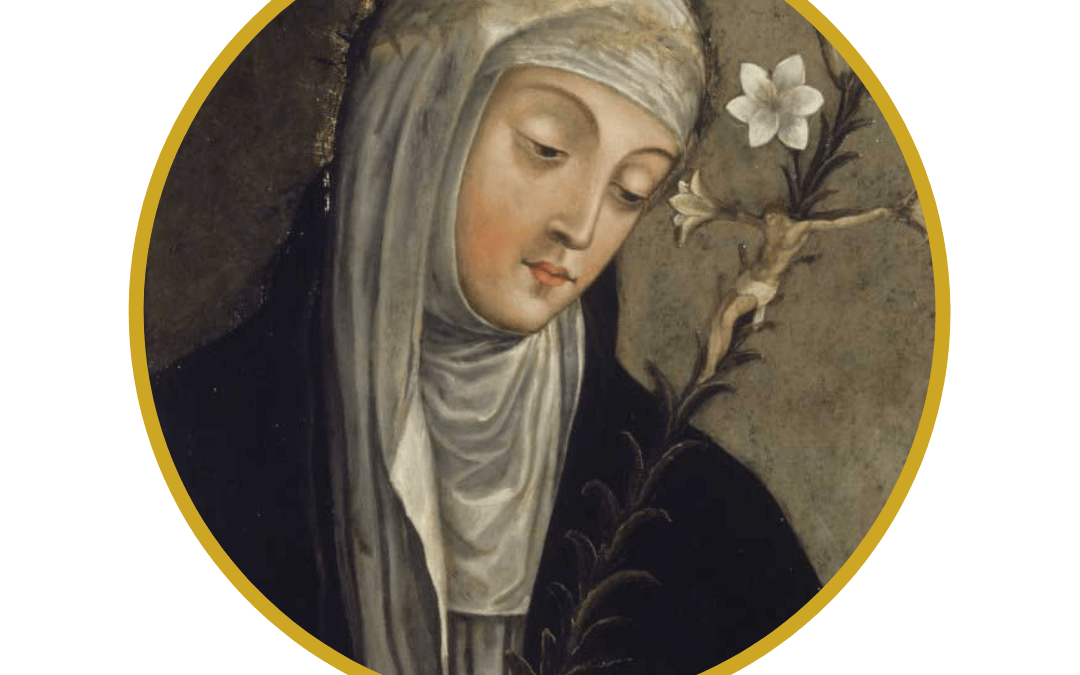
by popadmin | Apr 24, 2022 | CIC Saint Writeups
29 April: Feast of Saint Catherine of Siena. Catherine was born in Siena, Italy in 1347. She was the 25th child in a large family, although half her siblings did not survive childhood. Catherine was intensely religious; she began to experience God mystically and took a vow of virginity before she turned seven. Frequent visions of Christ, Mary, angels and saints inspired her holy, austere lifestyle. At age 16, one of Catherine’s sisters died. Her parents proposed that the widowed husband marry Catherine as a replacement, but Catherine vehemently opposed this. She fasted and cut her hair very short to mar her appearance. Her parents tried to force the marriage but Catherine’s extreme fasting, prayer, and religious conviction finally made them relent. Catherine joined the Third Order of St. Dominic, which allowed her to live at home as a religious. She lived quietly isolated. She received the stigmata, had divine visions, and could levitate while praying. When she was 21, Catherine experienced a “mystical marriage to Christ” and was given an invisible ring made of Jesus’s skin. In a vision, she was told to re-enter public life to help the poor and sick. She went to work in hospitals and homes. She once visited a condemned prisoner and was credited with saving his soul, which she saw being taken up to heaven as he died. Her reputation attracted a circle of followers. Before long, she had scribes to help her correspondence with many influential Church and secular leaders, including kings, queens, and the pope. The leaders asked for her advice. She travelled Europe seeking reconciliation between warring parties. She urged Pope Gregory XI to return to Rome and lobbied on behalf of the legitimacy of Pope Urban VI during the Great Schism of 1378. Catherine also looked after victims of the Black Plague, caring for the worst patients and burying the dead. She established a monastery for women. Her rich prayer life included frequent visions and ecstasies, recorded as a dialogue between a soul and God, in her Dialogue of Divine Providence. Her 400-some written letters are considered a great work of theology and literature. Her extreme fasting may have contributed to her death at the age of 33. She was canonized by Pope Pius II in 1461. In 1970, she was given the title of Doctor of the Church by Pope Paul VI (a Doctor of the Church is a saint recognized as having been of particular importance regarding their contribution to theology or doctrine).
“Be who God meant you to be, and you will set the world on fire.” – St Catherine of Siena
Ideas for celebrating this feast at home:
- Watch on FORMED: “Who is St. Catherine of Siena?” (with Dr. Tim Gray); or a children’s version here.
- Many meaningful quotes are attributed to St. Catherine (see here). As a spiritual reflection, choose one to copy and decorate (perhaps with a symbol of St. Catherine: heart, cross, ring, stigmata, or lily).
- Write an encouraging letter: although St. Catherine was neither wealthy nor well-educated, she wrote influential letters. Think of someone who needs advice or encouragement and write them a letter.
- Pray for and write to a nurse or firefighter: Catherine is the patron of nurses and firefighters. Maybe also drop off a treat at your local fire department or nurse’s station.
- Bake bread for the poor: St. Catherine baked bread daily for the poor. Follow her lead and make some bread to share with the poor. Or, bake some bread to give to someone who is poor in spirit and might just need a lift. Here is a recipe for St. Catherine “peace bread” in honor of her work for world peace.
- For a feast day dinner, an Italian meal is perfect since St. Catherine was from Italy. Try making Pasta Santa Caterina with garlic bread, salad with Italian dressing, and a Tiramisu or Pineapple Upside Down cake for dessert (the pineapple rings symbolizing how Catherine was espoused to Christ by an invisible nuptial ring). Click here for more menu ideas.
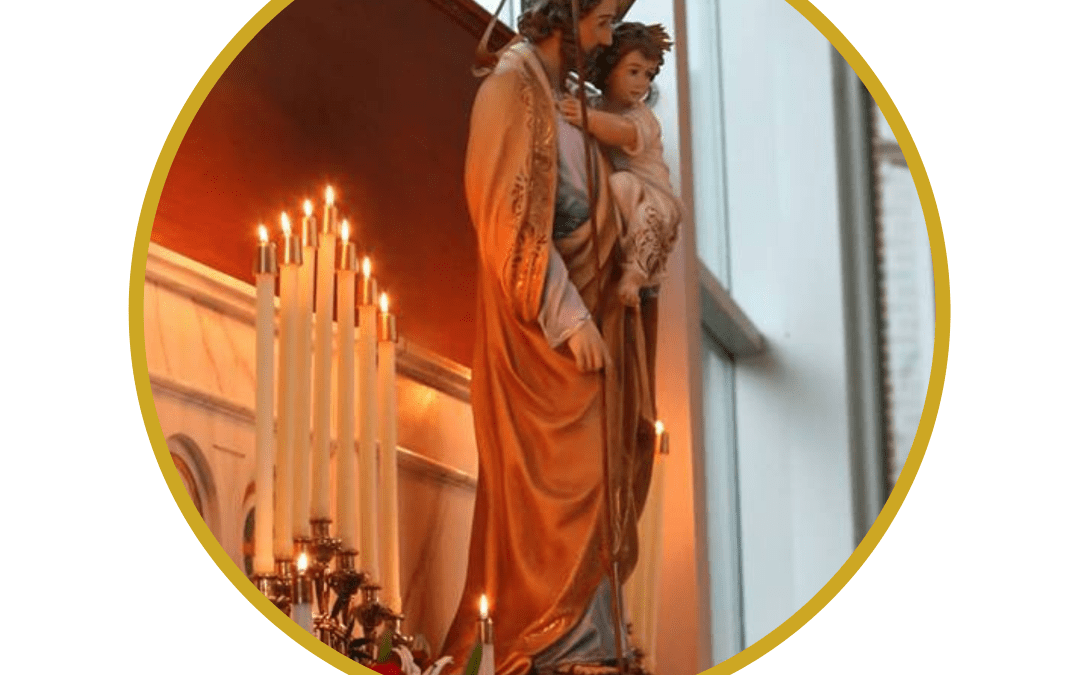
by popadmin | Mar 18, 2022 | CIC Saint Writeups
19 March: Solemnity of Saint Joseph. The Church celebrates two feast days for Saint Joseph: 19 March for Joseph the Husband of Mary and 1 May for Joseph the Worker. The 19th of March has been the more commonly celebrated feast; it wasn’t until 1955 that Pope Pius XII established the Feast of St. Joseph the Worker (1 May is also “May Day” – International Workers’ Day). Saint Joseph is well known as the head of the Holy Family. He is silent in scripture, yet, spoken words are not needed for us to understand his integrity and godliness. Here is what Pope Benedict XVI says: “The silence of Saint Joseph is given a special emphasis. His silence is steeped in contemplation of the mystery of God in an attitude of total availability to divine desires. It is a silence thanks to which Joseph, in unison with Mary, watches over the Word of God, known through the Sacred Scriptures, continuously comparing it with the events of the life of Jesus; a silence woven of constant prayer, a prayer of blessing of the Lord, of the adoration of His holy will and of unreserved entrustment to his providence. It is no exaggeration to think that it was precisely from his “father” Joseph that Jesus learned… Let us allow ourselves to be “filled” with Saint Joseph’s silence! In a world that is often too noisy, that encourages neither recollection nor listening to God’s voice.” Saint Joseph is the guardian and patron of the Universal Church, as well as of many causes including workers, fathers, and a happy death, due to the tradition that he died in Jesus and Mary’s arms.
“Inspired by the Gospel, the Fathers of the Church from the earliest centuries stressed that just as St. Joseph took loving care of Mary and gladly dedicated himself to Jesus Christ’s upbringing, he likewise watches over and protects Christ’s Mystical Body, that is, the Church.” – Pope St. John Paul II
Ideas for celebrating this feast:
- It is traditional to wear red for St. Joseph’s Day. Set the table with red cloths or candles and decorate the tabletop with tools and a sprinkle of sawdust (tip: breadcrumbs look like sawdust!). Place white lilies in your home to remember St. Joseph’s purity.
- Click here to see how to make a “St Joseph Altar” with all the traditional foods. Or, simply serve up sloppy Joe sandwiches as a fun way to remember Beloved Saint Joseph!
- Traditional St. Joseph’s day foodsinclude breads shaped in cross and staff form, figs, olives, dates, artichokes, fruits, salads, and sweets of all kinds especially donuts, cream puffs, biscotti and Italian cookies. For the main meal you could serve traditional fish and “St. Joseph’s Sawdust”: toasted bread crumbs over pasta, representing sawdust from St. Joseph’s workshop. Here’s a recipe.
- Children can do a craft building/making something out of wood (twigs, popsicle stick, etc) to remember Joseph’s work as a carpenter.
- In Italy and Spain, Father’s Day is celebrated annually on St. Joseph’s Day. Whatever man in your life has guided you or deepened your faith (whether it’s a biological father, adoptive father, foster father, grandfather, father-in-law or good priest): St. Joseph’s Day is a perfect day to honor them! Send a card; deliver a dinner; or offer a Mass in their honor.
- Give your worries to Joseph so you can get some rest: It is said that St. Joseph, the “Terror of Demons,” even frightens demons in his sleep, such is his power and strength! Ask St. Joseph to pray for you and take your worries away.
- Participate in the 33-day consecration to St. Joseph
- Pray the rosary with your family, saying the Litany of Saint Joseph at the end.
- Saint Joseph’s life is a model of Christian virtue. Perhaps we honor him best when we imitate his virtues (visit this website for insight into all of Joseph’s virtues).
- CELEBRATE THIS FEAST WITH YOUR POP FAMILY: On Saturday, 19 March after the 5pm Mass, come and join in the procession from church to the PAC. There will be dinner, a photo booth, and other fun activities to celebrate St. Joseph and all fathers!
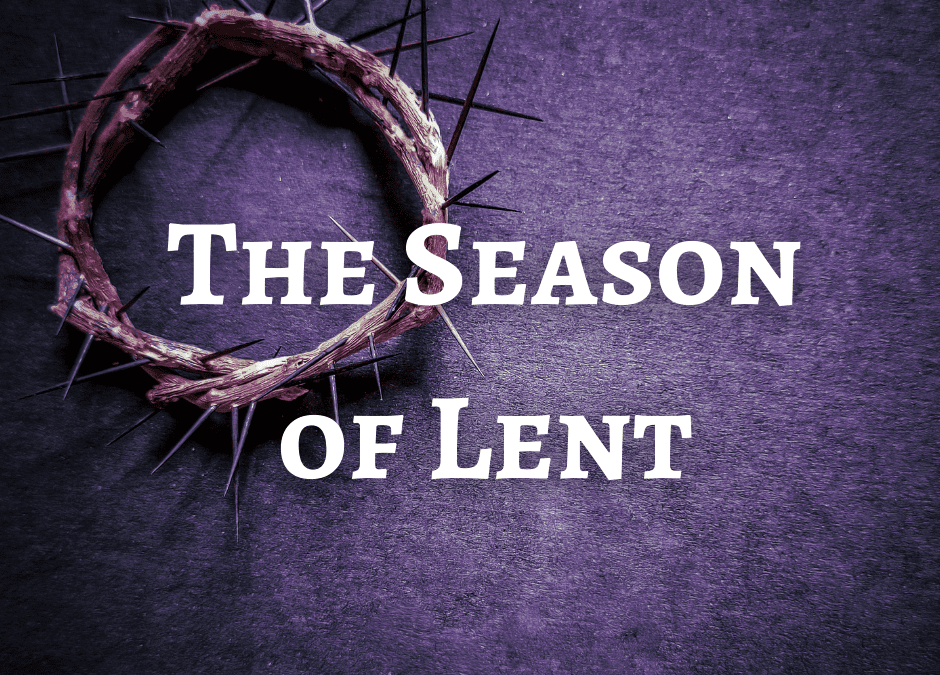
by popadmin | Feb 27, 2022 | CIC Saint Writeups
Ideas for Observing Lent in the Domestic Church
LENT: a time to grow closer to God.
A time to take up practices that lead us toward him and to leave behind practices that distract us from him.
“Unless there is a Good Friday in your life, there can be no Easter Sunday.” – Ven. Fulton Sheen
“Apart from the cross, there is no other ladder by which we may get to heaven.” – St. Rose of Lima
- Read Prince of Peace Catholic Church’s The Shape of Lent and the Paschal Mystery 2022 and consider participating in the community-wide weekly sacrifices for Lent.
- Pray, go to mass, confession, and adoration of the Blessed Sacrament as often as you can.
- Read the Bible daily; even just a chapter a day! Read Scripture and stories of the saints to children.
- Home décor: your home can reflect the penitential season (use burlap; cactus instead of flowers; simple candles and religious items on tables, mantles, etc). Incorporate the liturgical color of purple.
- Movie sacrifice idea: instead of a favorite show, watch a Catholic saints story or a religious film (free with your parishioner FORMED account). Or, use that time to read about the Faith or lives of the saints.
- Make pretzels:pretzels were first baked during Lent (story here) because they can be made with water, flour, and salt. The shape came from a posture of prayer: arms crossed and hands on opposite shoulders. Recipe here.
- Save money to give to the poor: brainstorm ideas for how you can do this as a family. Perhaps eat at home instead of going out and give the extra $$ to charity. Are there little luxuries that can be sacrificed and the money donated? Some families might choose to do an offering jar. As a family, place all your spare change in the jar for the entire season of Lent, and let your kids put it in the offering plate on Easter Sunday.
- Pray the “Stations of the Cross” on Fridays. If you can’t go to the one at church, it is simple to pray them at home. Click here to print out the prayers (and pictures that children can color).
- Make a prayer chain: write a person or prayer request on 40 strips of paper. Assemble them into a paper chain. Remove one link per day, and pray for that thing with your kids.
- Build a Lenten Cross. Similar to an Advent wreath, you light one or more candles each night during dinner for the entire Lenten season.
- Sign up for “Holy Heroes” free Lenten adventure (kids ages 5-12): com
- Make a salt dough “crown of thorns” to place on your table: link here. For each Lenten sacrifice made, pull a toothpick out. The goal is to remove all the “thorns” by Easter. (Additionally, you can paint it gold and decorate with flowers where the “thorns” once were and use as an Easter centerpiece.)
- Bake an edible “crown of thorns” for Ash Wednesday or Good Friday: simply braid bread dough into a crown shape and bake. Push pretzel sticks (‘thorns’) into the crown as soon as it comes out of the oven. (idea here)
- Similar to the crown of thorns activity, you could also do “sacrifice beans.” On the table is a bowl filled with dried beans next to a jar. When you make a sacrifice for Jesus, put a bean in the jar. Then, on Easter morning, children wake up to find that the beans that have accumulated in the jar during Lent have been changed into yummy jelly beans (or other such candies).
- Make some empty tomb crafts with kids. Try this Calvary Hill Plant that grows throughout Lent. Decorate with flowers on Easter morning and add a little statue of Jesus outside the empty tomb to represent the risen Lord. Click here for more. Kids love this fun project and you can use it as your Easter centerpiece!
- Try to set a daily goal to sacrifice in these areas:
- Diet: sacrifice a food or drink you love
- Physical: do something physically difficult every day (push-ups; daily walk; run a mile; etc.)
- Spiritual: spend daily time with God in prayer and Scripture
“The Lord measures out perfection neither by the multitude nor the magnitude of our deeds, but by the manner in which we perform them.” – St. John of the Cross
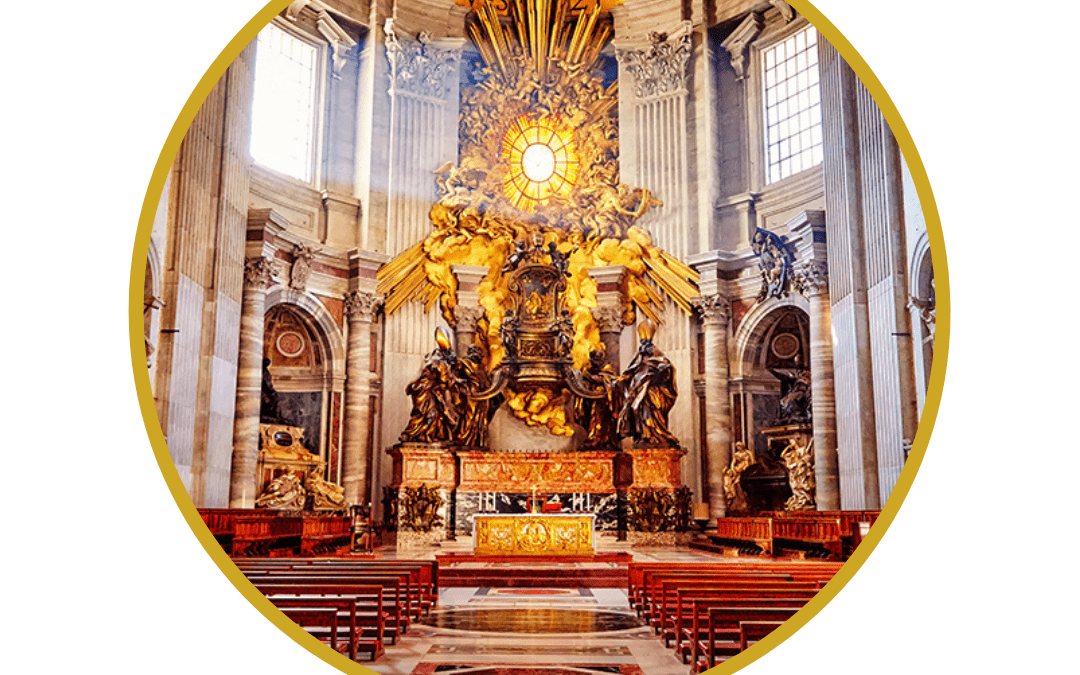
by popadmin | Feb 22, 2022 | CIC Saint Writeups
22 February: Feast of the Chair of Saint Peter. While it may seem like a strange feast, the church is not just celebrating a piece of furniture today. This Feast has been celebrated since the early Church and has multifold meaning. First, it does refer to the actual chair that Peter sat on as the first pope. Officials in the Roman Empire would sit on chairs for official work. This tradition was replicated in the Church. Cathedra is Latin for “chair” or “throne” and denominates the chair or seat of a bishop, hence “cathedral” denominates the bishop’s church in an episcopal see. The physical “chair of Peter” is encased in a sculpture designed by Bernini located in Saint Peter’s Basilica in Rome. In the apse of the Basilica, a great bronze throne encloses the wooden chair from the ninth century, believed to be Peter’s own chair. On the chair itself, Bernini depicts three scenes from Peter’s life: the giving of the keys (symbolizing authority to lead the Church), the washing of feet (symbolizing Peter’s office is one of service), and Jesus’ instruction to “Feed my sheep” (pointing to Peter’s role as teacher and guide). Below the chair are statues of four doctors of the Church (Saints Athanasius, John Chrysostom, Ambrose, Augustine). Above the throne is an oval window with the Holy Spirit depicted as a dove. The symbolism of this great work of art is clear: the Holy Spirit guides the Church through Saint Peter and his successors, who authoritatively teach the Word of God through Sacred Scripture and Tradition. This feast day is also about the spiritual authority bestowed upon Saint Peter by Jesus: “You are Peter, and on this rock I will build my church, and the gates of hell shall not prevail against it. I will give you the keys to the kingdom of heaven, and whatever you bind on earth shall be bound in heaven, and whatever you loose on earth shall be loosed in heaven.” (Matt. 16:18-19). Pope Benedict XVI wrote: “So what was the ‘Chair’ of St Peter? Chosen by Christ as the ‘rock’ on which to build the Church, he began his ministry in Jerusalem… The Church’s first ‘seat’ was the Upper Room, and it is likely that a special place was reserved for Simon Peter in that room where Mary, Mother of Jesus, also prayed with the disciples… Then Peter went to Rome, the center of the Empire… So it is that the See of Rome, which had received the greatest of honors, also has the honor that Christ entrusted to Peter of being at the service of all the particular Churches for the edification and unity of the entire People of God… The See of Rome, after St Peter’s travels, thus came to be recognized as the See of the Successor of Peter, and its Bishop’s ‘cathedra’ represented the mission entrusted to him by Christ to tend his entire flock… Celebrating the ‘Chair’ of Peter, therefore, means attributing a strong spiritual significance to it and recognizing it as a privileged sign of the love of God, the eternal Good Shepherd, who wanted to gather his whole Church and lead her on the path of salvation.” In the fourth century, St. Jerome wrote to Pope Damascus I: “I follow no leader but Christ and join in communion with none but Your Blessedness, that is, with the chair of Peter. I know that this is the rock on which the Church has been built.”
Ideas for celebrating this feast at home:
- Pray the Litany of St. Peter.
- See images of the Chair of Peter here. Read more about the chair here.
- Watch “Peter: Keeper of the Keys” on FORMED
- A symbol for Saint Peter is keys (the keys to the kingdom). A fun feast day activity would be to make keys out of craft supplies, cookie dough, pancake batter, or bread dough.
- Have children to design a “chair” for St. Peter out of pantry supplies (cookies, crackers, nut butters, candies, pretzels, etc). Ideas here and here.
- For dinner, make Baked Rockfish in honor of Peter “the rock” (or any type of fish, since Peter was a fisherman!) Serve it alongside a “Golden Chair of St. Peter fruit salad”
(sources: ncregister.com; simplycatholic.com; www.vaticannews.va; Franciscanmedia.org; edwardsri.com)
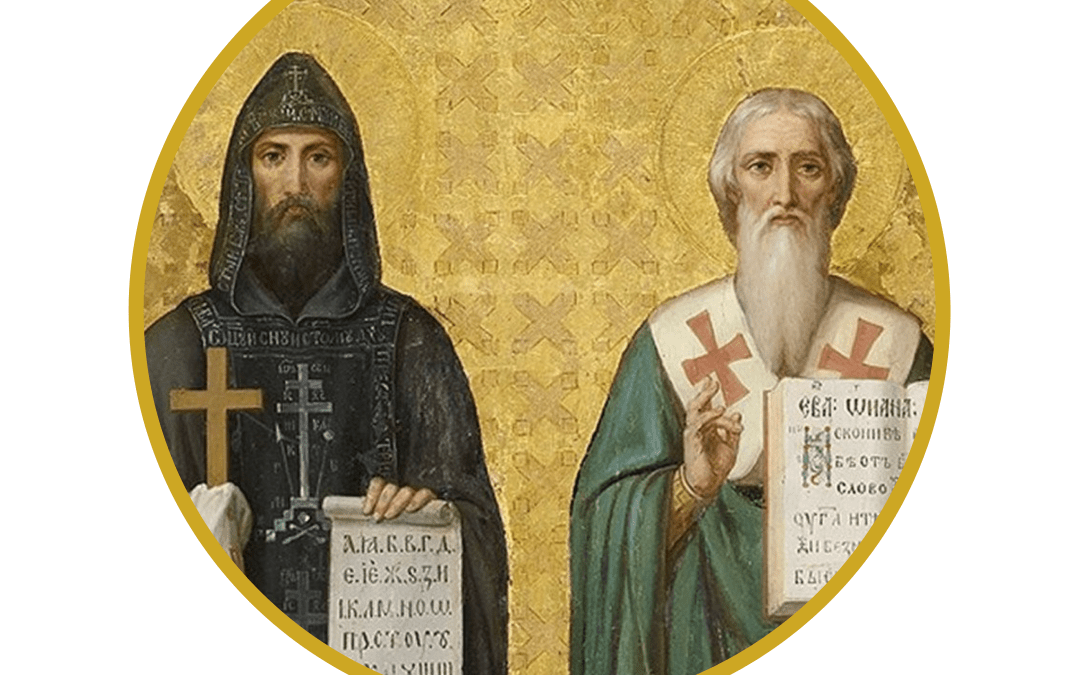
by popadmin | Feb 13, 2022 | CIC Saint Writeups
14 February: Feast of Saints Cyril and Methodius. Today, the Church honors two brothers known as the “Apostles of the Slavs” for their tireless work in spreading the Gospel throughout Eastern Europe. Born into a prestigious senatorial family in Thessalonica, in 815 and 826, Cyril and Methodius received an excellent education but renounced their wealth and status. They chose instead to become priests. Both were in a monastery when authorities from the Khazar Empire sent for a Christian missionary. Cyril was chosen and Methodius accompanied. They converted many. By the middle of the ninth century, Prince Rastislav of Moravia wrote to the Byzantine Emperor Michael III, asking for teachers who could teach his people the Christian faith in their own language. Cyril and Methodius were chosen. When they set out on this missionary journey, letters of a new Slavonic alphabet were revealed to them in answer to prayer. Together, they invented the “Cyrillic alphabet” as a way to communicate the faith. They translated the Scriptures and the Liturgy into this Slavonic. They said of their alphabet, ‘Receive this gift, which is more precious and greater than all silver and gold and precious stones and all magnificent wealth’. The two labored in Moravia for years, achieving great success in spreading the Faith. Their Byzantine origins and use of the vernacular language caused German church officials to regard them with suspicion. However, after being summoned to Rome, they met with Pope Adrian II who warmly approved of their methods. Cyril and Methodius were commended by the pope for their missionary activity and ordained bishops. Yet Cyril would not return to Moravia; he died in Rome on February 14, 869. He is buried in the Basilica of San Clemente. Methodius returned to Moravia and labored as a missionary among the Hungarians, Bulgarians, Dalmatians, and in Carinthia. Falling again under suspicion, he returned to Rome and defended the use of the Slavonic language in the liturgy. The Pope bestowed upon him the dignity of archbishop. After his return to Moravia, Methodius spread the light of faith in Bohemia and Poland, and went to Moscow to establish the diocese of Kiev. He suffered imprisonment for three years under German critics; Pope John VIII managed to have Methodius freed and reinstated as archbishop. Pope John VIII continued to support Methodius’ use of the Slavic language, despite continuing controversy with the German church. Eventually, with the help of Greek priests, Methodius translated the whole Bible into the language that is known today as Church Slavonic. After a life spent spreading the Faith, Methodius died on April 6, 885. Both brothers are venerated in the Orthodox Church as saints with the title of “equal-to-apostles”. In 1880, Pope Leo XIII introduced their feast into the calendar of the Roman Catholic Church. In 1980, Pope St. John Paul II declared them co-patron saints of Europe, together with Saint Benedict of Nursia.
Saint Valentine: who was he?
Although hard to verify, legend states that Valentine, along with St. Marius, aided Christian martyrs during the Claudian persecution. Claudius issued a decree forbidding marriage, to increase army troops (believing single men better soldiers than married men). Valentine defied this decree and urged young lovers to come to him in secret to be married. Eventually he was discovered, arrested, and condemned to death. While in prison, Valentine befriended the jailer and his blind daughter. The daughter often him brought food and messages. Valentine was able to convert both father and daughter to Christianity. Legend says he also miraculously restored the daughter’s sight. The night before his execution, he wrote a farewell message to the girl and signed it affectionately “From Your Valentine,” a phrase that lives on today. He was executed on February 14, 273. The Martyrology says, “At Rome, on the Flaminian Way, the heavenly birthday of the blessed martyr Valentine, a priest. After performing many miraculous cures and giving much wise counsel he was beaten and beheaded under Claudius Caesar.” A valentine has become a universal symbol of friendship and affection shared on the anniversary of his death: St. Valentine’s Day.
(sources: Catholicnewsagency.com; catholicculture.org; Fr. Tim Pike, CMP; The Catholic All Year Compendium by K. Tierney)






Recent Comments